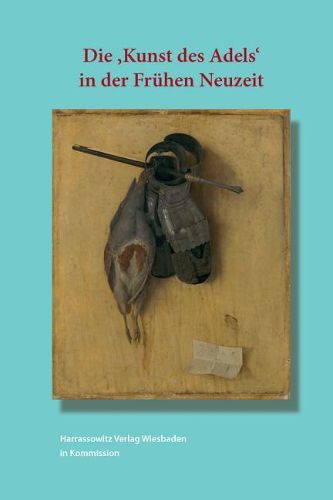Readings Newsletter
Become a Readings Member to make your shopping experience even easier.
Sign in or sign up for free!
You’re not far away from qualifying for FREE standard shipping within Australia
You’ve qualified for FREE standard shipping within Australia
The cart is loading…






English summary: In early modern Europe, membership in the nobility was not only a matter of social status, a rank one automatically achieved by virtue of high birth, but rather the individuals within this social group (and those who aspired to it) had to be validated frequently through specific actions and demeanor, as well as compete with other members of the nobility and against their non-aristocratic contemporaries. These performative aspects of nobility indicated a certain way of leading a noble life that was its own type of art, which could manifest itself across a number of different fields of competition and, to that end, also encouraged a specific engagement with the arts in a narrow sense - with literature, music, paintings, and architecture. This meant both that nobles operated in modes as patrons, connoisseurs, and consumers and also that productive artistic praxis was viewed as having traits of nobility. The interdisciplinary articles collected in this anthology offer comparative perspectives from European history on the questions of how the similar social and normative concepts of noble and art correlated to each other in the early modern period, and how members of the nobility were understood as artists and how art was considered noble. The individual studies come from the academic disciplines of languages and literature, history, and music as well as art history and they establish not only new perspectives on the culture of nobility between 1500 and 1800, but at the same time they also trace the genesis of the modern concept of the autonomy of art. German description: Die Zugehorigkeit zum Adel war im fruhneuzeitlichen Europa nicht nur ein sozialer Status, den man durch eine hohe Geburt unzweifelhaft besass - sie musste vielmehr kontinuierlich in bestimmten Haltungen und Handlungen beglaubigt werden, sowohl gegenuber Mitgliedern des eigenen Standes als auch gegenuber nicht-adligen Zeitgenossen. Dieser performative Aspekt von ‘Adeligkeit’ verweist auf eine eigene ‘Kunst, ein adeliges Leben zu fuhren’, die sich auf den verschiedensten Feldern zeigte. Dazu zahlte insbesondere auch ein bestimmter Umgang mit den ‘Kunsten’ im engeren Sinne - mit Literatur, Musik, Malerei und Architektur. Sowohl in spezifischen Modi der Patronage, der Kennerschaft und des Konsums, aber auch der produktiven kunstlerischen Praxis lassen sich Spuren von ‘Adeligkeit’ entdecken. Der interdisziplinar angelegte Sammelband geht in einer europaisch-vergleichenden Perspektive der Frage nach, wie die gleichermassen sozialen und normativen Begriffe des ‘Adels’ und der ‘Kunst’ in der fruhen Neuzeit aufeinander bezogen waren, wie sich Adlige als ‘Kunstler’ verstanden und Kunst als ‘adlig’ entworfen wurde. Die einzelnen Beitrage aus den Feldern der Sprach- und der Literaturwissenschaft, der Geschichts- und der Musikwissenschaft sowie der Kunstgeschichte eroffnen daher nicht nur neue Perspektiven auf die Adelskultur zwischen 1500 und 1800, sondern zugleich auch auf die Genese eines modernen Begriffs der ‘autonomen Kunst’.
$9.00 standard shipping within Australia
FREE standard shipping within Australia for orders over $100.00
Express & International shipping calculated at checkout
English summary: In early modern Europe, membership in the nobility was not only a matter of social status, a rank one automatically achieved by virtue of high birth, but rather the individuals within this social group (and those who aspired to it) had to be validated frequently through specific actions and demeanor, as well as compete with other members of the nobility and against their non-aristocratic contemporaries. These performative aspects of nobility indicated a certain way of leading a noble life that was its own type of art, which could manifest itself across a number of different fields of competition and, to that end, also encouraged a specific engagement with the arts in a narrow sense - with literature, music, paintings, and architecture. This meant both that nobles operated in modes as patrons, connoisseurs, and consumers and also that productive artistic praxis was viewed as having traits of nobility. The interdisciplinary articles collected in this anthology offer comparative perspectives from European history on the questions of how the similar social and normative concepts of noble and art correlated to each other in the early modern period, and how members of the nobility were understood as artists and how art was considered noble. The individual studies come from the academic disciplines of languages and literature, history, and music as well as art history and they establish not only new perspectives on the culture of nobility between 1500 and 1800, but at the same time they also trace the genesis of the modern concept of the autonomy of art. German description: Die Zugehorigkeit zum Adel war im fruhneuzeitlichen Europa nicht nur ein sozialer Status, den man durch eine hohe Geburt unzweifelhaft besass - sie musste vielmehr kontinuierlich in bestimmten Haltungen und Handlungen beglaubigt werden, sowohl gegenuber Mitgliedern des eigenen Standes als auch gegenuber nicht-adligen Zeitgenossen. Dieser performative Aspekt von ‘Adeligkeit’ verweist auf eine eigene ‘Kunst, ein adeliges Leben zu fuhren’, die sich auf den verschiedensten Feldern zeigte. Dazu zahlte insbesondere auch ein bestimmter Umgang mit den ‘Kunsten’ im engeren Sinne - mit Literatur, Musik, Malerei und Architektur. Sowohl in spezifischen Modi der Patronage, der Kennerschaft und des Konsums, aber auch der produktiven kunstlerischen Praxis lassen sich Spuren von ‘Adeligkeit’ entdecken. Der interdisziplinar angelegte Sammelband geht in einer europaisch-vergleichenden Perspektive der Frage nach, wie die gleichermassen sozialen und normativen Begriffe des ‘Adels’ und der ‘Kunst’ in der fruhen Neuzeit aufeinander bezogen waren, wie sich Adlige als ‘Kunstler’ verstanden und Kunst als ‘adlig’ entworfen wurde. Die einzelnen Beitrage aus den Feldern der Sprach- und der Literaturwissenschaft, der Geschichts- und der Musikwissenschaft sowie der Kunstgeschichte eroffnen daher nicht nur neue Perspektiven auf die Adelskultur zwischen 1500 und 1800, sondern zugleich auch auf die Genese eines modernen Begriffs der ‘autonomen Kunst’.